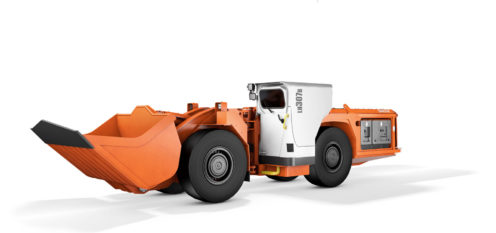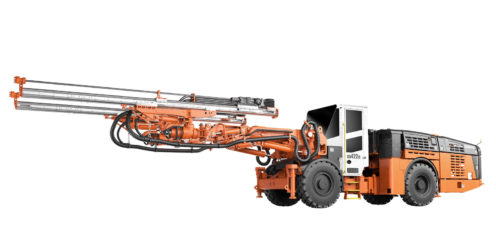The clean team
Awareness continues to grow about the potential health impacts of diesel particulate matter (DPM) and other underground engine emissions that also often dictate high mine ventilation costs. Sandvik is launching battery-driven underground equipment to help mines address present and future emissions challenges.
As regulations become stricter, mines need cleaner-energy solutions that help reduce DPM emissions in their underground operations. Replacing diesel equipment with battery-driven versions helps eliminate such contaminants and associated respiratory risks while reducing operating costs.
Charging ahead
Sandvik DD422iE, the mining industry’s first battery-trammed development jumbo, and Sandvik LH307B, a seven-tonne, battery-powered loader, combine the freedom of operation typical of traditional diesel equipment with the major environmental, health and safety (EHS) benefits of electric power.
“Exposure to elevated diesel exhaust concentrations has been linked to negative health effects such as eye and nose irritation, headaches, nausea and asthma, and studies have shown it may even be a carcinogen,” says Stuart Evans, vice president EHS at Sandvik Mining and Rock Technology. “This is why it was of utmost importance for us to introduce products that mitigate those risks.”
Electric tramming
Sandvik DD422iE is the latest version of a well-proven automated mining jumbo that eliminates the need for a diesel engine for tramming from one tunnel to another.
The rig, designed for underground development drilling and tunnelling, uses electrical power to drill, relying on a mine’s power supply network. Battery energy is used for tramming and active network compensation for higher performance during drilling. It does not need separate charging as the rig charges up its battery automatically during the drilling cycle.
Furthermore, downhill tramming does not consume power but rather tops up the batteries of Sandvik DD422iE. The transmission system of the carrier converts the kinetic energy from the wheels into stored energy in the battery. A further benefit, compared with a conventional driveline, is reduced heat generation.
Emissions knock-out
The elimination of the diesel engine essentially means zero emissions. In addition to major cost-saving potential in fuel consumption and fuel logistics, this also yields significant EHS benefits, an area that hardly any mine operator can overlook in view of increasingly stringent regulation and growing stakeholder expectations. Lower noise levels and elimination of exhaust emissions, including DPM, NOx and CO2, provide a healthier and more pleasant working environment for operators and maintenance personnel. Optimal conditions may also offer potential to scale back mine ventilation.
In addition to the new battery driveline, innovations of Sandvik DD422iE include a 3D scanning navigation option and a new improved boom option. The navigation function shortens set-up time at the beginning of each drilling cycle and automatically scans overbreak and underbreak, providing valuable information to optimize the drilling operation. Smart boom positioning and drilling control system increase accuracy and reduce cycle times as well as drilling costs. The 3D navigation option is compatible with the iSURE drill plan design and data collection software. All this directly translates to more efficient mine development in terms of metres per month.
The universal electric system of Sandvik DD422iE is multi-voltage compliant, encompassing the range of 380–1,000 V and both the 50Hz and 60Hz frequencies. For contractors, this means flexible usability in several different countries.
The usable life of the rig’s power pack is designed to cover its entire lifetime. The molten salt battery technology (sodium-nickel-chloride) reduces fire risk and thus further improves the EHS characteristics of the rig.

TECH SPECS: SANDVIK LH307B
- Tramming capacity: 6.7 tonnes
- Standard bucket: 3.0 cubic metres
- Approximate weight: 22 tonnes
- Battery pack: Lithium titanate oxide (LTO)
Value added
- No exhaust emissions: better mine air quality, potential for ventilation cost savings
- Lower heat emissions: savings potential in ventilation
- Less noise: improved working environment
- Clean electrical power with no cable: improved operational flexibility, no limitations for vehicles in the same area
- Advanced LTO battery technology: safer and faster recharging, long lifetime
“The advanced battery driveline system with multi-voltage compatibility offers huge possibilities to all underground mine owners and drilling contractors,” says Johannes Välivaara, product manager, development drills, for Sandvik Mining and Rock Technology. “This is a truly flexible piece of advanced machinery that delivers immense value for drill operators as well as mine managers.”
Best of both worlds
Sandvik LHDs have for many years thrived in demanding loading applications, both diesel-powered and electric versions.
Both conventional alternatives have their relative strengths and weaknesses: A diesel engine provides sustainable independent operational capability, but it also inevitably entails cumbersome and costly fuel logistics and exhaust emissions. Electric loaders eliminate the exhaust emissions altogether and also much of the heat emissions, but the cable prohibits the use of other vehicles in the same area and limits the freedom of movement and tramming distance.
The new Sandvik LH307B brings the best of both worlds to underground mines: clean, emission-free electrical power, to provide the independence of movement similar to diesel loaders, yet without the related diesel emissions and costs.
Long-lasting loader life
The payload of 6.7 tonnes will be moved using components shared with the diesel version, with much the same performance characteristics. As with the diesel version, the Vehicle Control and Management system monitors all loader parameters, expediting troubleshooting and minimizing unscheduled downtime. Furthermore, Sandvik LH307B is ready for use with Sandvik mine automation and information management systems.
Lithium titanate oxide (LTO) battery technology enables rapid recharging for continuous operation with a single battery pack – in other words, there is no need to swap batteries during or between shifts. LTO batteries also have superior thermal stability and resistance to internal short circuits, making them one of the safest lithium-ion batteries. Liquid cooling guarantees a long battery lifetime across a broad range of ambient temperatures – long enough to cover the useful service life of the loader itself, in fact.

TECH SPECS: DD422iE
- Feed length: 5.27 m
- Hole diameter: 43–64 mm
- Weight: 27.5 tonnes
- Mast type: SB60/SB60i
Value added
- Reduced DPM, NOx and CO2 emissions
- Eliminates costs related to fuel logistics
- Potential for cost savings in mine ventilation
- Recharge during drilling – no interruption in production
- Multi-voltage compliant system allows flexible operations in any mine
- Improved underground safety thanks to long-lasting molten salt battery technology
The single-battery strategy offers several tangible benefits. Eliminating the need for spare batteries effectively cuts capex costs. There is no need for a dedicated crane and battery swap area, which again cuts costs and also avoids the risk of damage to the battery and loader frame associated with battery swaps. In addition, operators and maintenance personnel can avoid a potentially significant risk of injuries caused by manual battery handling.
“In the future, as mines go deeper, one of the biggest challenges that mining at depth presents is the need for increased ventilation and cooling,” says Wayne Scrivens, product line manager, load and haul, Sandvik Mining and Rock Technology. “Sandvik LH307B offers the opportunity to reduce ventilation and heat as well as the obvious health benefits of no diesel exhaust emissions being emitted into the underground environment. These are also the first steps towards the goal of an all-battery electric fleet, completely eliminating the use of a diesel engine.”

/https%3A%2F%2Fsolidground.sandvik%2Fwp-content%2Fuploads%2F2016%2F09%2FBATTERY01_A_ArtikelImage-top-1600x750.jpg)
/https%3A%2F%2Fsolidground.sandvik%2Fwp-content%2Fuploads%2F2016%2F09%2FBATTERY03_A_ArtikelImage-top-1600x750.jpg)
/https%3A%2F%2Fsolidground.sandvik%2Fwp-content%2Fuploads%2F2024%2F12%2FFasloc-SF-Styren-Free-alt.jpg)
/https%3A%2F%2Fsolidground.sandvik%2Fwp-content%2Fuploads%2F2019%2F10%2F47246191292_1600x570.jpg)
/https%3A%2F%2Fsolidground.sandvik%2Fwp-content%2Fuploads%2F2019%2F10%2FHenrik_Ager_foto_oskar_omne0015_1600x570.jpg)
/https%3A%2F%2Fsolidground.sandvik%2Fwp-content%2Fuploads%2F2019%2F10%2FGearingUp_1600x570.jpg)
/https%3A%2F%2Fsolidground.sandvik%2Fwp-content%2Fuploads%2F2019%2F08%2FBasic_1600x570-Greenwood-02.jpg)
/https%3A%2F%2Fsolidground.sandvik%2Fwp-content%2Fuploads%2F2019%2F04%2FIll-Sandvik-SustainMining_part2.jpg)
/https%3A%2F%2Fsolidground.sandvik%2Fwp-content%2Fuploads%2F2018%2F11%2FVamos-01_1600x570.jpg)
/https%3A%2F%2Fsolidground.sandvik%2Fwp-content%2Fuploads%2F2018%2F06%2FGhana_01_1600x570.jpg)
/https%3A%2F%2Fsolidground.sandvik%2Fwp-content%2Fuploads%2F2018%2F02%2FBorden-Lake_1600x570_02.jpg)
/https%3A%2F%2Fsolidground.sandvik%2Fwp-content%2Fuploads%2F2017%2F08%2FPractice_Safety_1_1600x570.jpg)
/https%3A%2F%2Fsolidground.sandvik%2Fwp-content%2Fuploads%2F2017%2F05%2FMiners-going-green_1600x570.jpg)
/https%3A%2F%2Fsolidground.sandvik%2Fwp-content%2Fuploads%2F2017%2F03%2FSafety-HX900_1600x570_04.jpg)